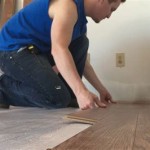Radiant Floor Heating Installation Cost: A Comprehensive Guide
Radiant floor heating, a system that warms a room directly from the floor, has gained popularity for its comfort, energy efficiency, and ability to eliminate drafts and cold spots. While the initial investment might seem significant, understanding the various factors influencing the installation cost is crucial for homeowners considering this heating option. This article provides a comprehensive overview of radiant floor heating installation costs, exploring the different types of systems, cost components, and considerations for accurate budgeting.
The cost of installing radiant floor heating varies depending on several key variables, including the type of system, the size of the area being heated, the existing floor structure, and the complexity of the installation. Generally, costs can range from $8 to $25 per square foot for hydronic systems and $10 to $20 per square foot for electric systems. These are just broad estimates, and actual costs can fluctuate based on specific project details. It is essential to obtain detailed quotes from qualified contractors to obtain an accurate estimate for a particular project.
Two primary types of radiant floor heating systems are available: hydronic and electric. Hydronic systems circulate heated water through pipes embedded in the floor, while electric systems use electric resistance cables or mats to generate heat. Each system has its advantages and disadvantages, which contribute to the overall installation cost. Understanding these differences is fundamental to making an informed decision and properly budgeting for the project.
Hydronic Radiant Floor Heating Systems: Cost Factors
Hydronic systems typically involve a higher initial investment than electric systems due to the complexity of their installation. The core components include a boiler or water heater, a manifold to distribute the heated water, tubing embedded in the floor, and a control system. The boiler or water heater, which serves as the heat source, can significantly impact the overall cost. Options include gas boilers, electric boilers, heat pumps, and even solar thermal systems. The choice depends on factors such as fuel availability, energy efficiency requirements, and budget considerations. A high-efficiency boiler, while more expensive upfront, can lead to long-term energy savings.
The manifold, a central distribution point for the heated water, adds to the installation cost. Manifolds regulate the flow of water to different zones, allowing for independent temperature control in various rooms. The complexity of the manifold system depends on the number of zones and the level of automation desired. More sophisticated manifolds with advanced controls will naturally increase the overall cost.
The tubing itself, typically made of PEX (cross-linked polyethylene), constitutes a significant portion of the material cost. The amount of tubing required depends on the size of the area being heated and the spacing between the tubes. Closer spacing results in more even heat distribution but also requires more tubing, increasing the material cost. Installation labor also influences the cost, as the tubing must be carefully installed and connected to the manifold. Concrete slab installations tend to require more labor than thinner applications using a gypcrete or wood subfloor.
Installation costs for hydronic systems are also affected by the existing floor structure. Installing radiant floor heating in a new construction project is generally less expensive than retrofitting an existing home. Retrofitting often involves removing existing flooring, preparing the subfloor, and potentially modifying the framing to accommodate the tubing. This adds to both labor and material costs. Additional costs might include plumbing modifications to connect the system to the existing water supply and drainage.
The control system for a hydronic radiant floor heating system can range from basic thermostats to sophisticated smart home integrations. Programmable thermostats allow for scheduled temperature adjustments, optimizing energy usage and comfort. Smart home integrations enable remote control and monitoring of the system, further enhancing convenience and energy efficiency. More advanced control systems typically involve higher upfront costs but can provide long-term savings and improved comfort.
Electric Radiant Floor Heating Systems: Cost Analysis
Electric radiant floor heating systems are generally less expensive to install initially compared to hydronic systems, particularly for smaller areas. These systems utilize electric resistance cables or mats embedded in the floor to generate heat. The primary cost components include the heating mats or cables, a thermostat, and electrical wiring. The simplicity of the installation process often translates to lower labor costs.
The cost of the heating mats or cables depends on the size of the area to be heated and the wattage per square foot. Higher wattage provides faster heating but also increases energy consumption. Selecting the appropriate wattage is crucial for balancing comfort and energy efficiency. The quality and durability of the mats or cables also influence the cost, with higher-quality products generally offering longer lifespans and better performance. Installation of these systems is simpler than hydronic, often involving rolling out the mats, securing them to the subfloor, and connecting them to the electrical wiring.
The thermostat is an integral part of an electric radiant floor heating system. Programmable thermostats allow for customized heating schedules, optimizing energy usage and comfort. Some thermostats also include features such as floor temperature sensing, which prevents overheating and ensures even heat distribution. As with hydronic systems, smart thermostats with remote control capabilities are available, further enhancing convenience and energy efficiency. The type of thermostat selected will contribute to the overall cost.
Electrical work is a significant cost factor in electric radiant floor heating installations. A dedicated circuit is typically required to handle the electrical load of the heating system. This might necessitate upgrading the electrical panel or adding new circuits, increasing the overall cost. The cost of electrical work depends on the complexity of the wiring and the labor rates of the electrician. It is critical to have a qualified electrician perform the electrical work to ensure safety and compliance with local codes.
Similar to hydronic systems, the existing floor structure influences the installation cost. Retrofitting an existing floor requires removing the flooring, preparing the subfloor, and potentially leveling the surface. This adds to the labor and material costs. However, the installation process for electric radiant floor heating is generally less invasive than hydronic systems, resulting in lower overall retrofit costs.
Additional Cost Considerations for Radiant Floor Heating
Beyond the core components and installation labor, several additional factors can impact the overall cost of radiant floor heating. These include the type of flooring being installed, the insulation levels, the complexity of the project, and permit fees.
The type of flooring significantly impacts the performance and cost of radiant floor heating. Some flooring materials, such as tile and stone, are excellent conductors of heat and are ideal for use with radiant floor heating systems. These materials allow for efficient heat transfer and optimal comfort. Other flooring materials, such as carpeting and thick wood, act as insulators and can reduce the effectiveness of radiant floor heating. If using less conductive materials, specialized installation techniques and higher system output might be necessary, potentially increasing the cost. Engineered wood flooring is often a good compromise, providing a balance of aesthetics and thermal conductivity.
Adequate insulation is crucial for maximizing the efficiency of radiant floor heating systems. Insulation reduces heat loss, directing the heat upwards into the room. Installing insulation beneath the radiant floor heating system can significantly improve its performance and lower energy bills. The cost of insulation varies depending on the type of insulation used and the area being insulated. Options include rigid foam insulation, spray foam insulation, and reflective foil insulation. Investing in high-quality insulation is a worthwhile investment that can pay for itself over time in energy savings.
The complexity of the project also influences the installation cost. Projects involving multiple zones, irregular room shapes, or challenging access can increase labor costs. Complex control systems with advanced features also add to the overall cost. It is important to discuss all aspects of the project with the contractor to identify potential challenges and ensure accurate budgeting.
Permit fees are another cost consideration. Building permits are typically required for radiant floor heating installations, ensuring compliance with local building codes and safety standards. The cost of permit fees varies depending on the location and the scope of the project. It is essential to factor in permit fees when budgeting for the installation.
Finally, it is always advisable to obtain multiple quotes from qualified contractors before making a decision. Comparing quotes allows for identifying the best value and ensuring that the contractor has the necessary experience and expertise. Checking references and reviewing online reviews can also provide valuable insights into the contractor's reputation and quality of work. A well-planned and properly installed radiant floor heating system can provide years of comfortable and efficient heating, making it a worthwhile investment for homeowners.

Radiant Floor Heating Cost To Install Heated Floors Fixr

How Much Does Radiant Floor Heating Cost 2025

Radiant Floor Heating Cost To Install Heated Floors Fixr

Is It Worth Installing Radiant In Floor Heating My Home Sun Electrical Ltd

How Much Does Radiant Floor Heating Cost 2025

How Much Does Radiant Floor Heating Cost Warmup Us

Slab Heating Cost Radiant Cooling Pert Floor System 3600 W

How Much Does Radiant Floor Heating Cost Pro Tool Reviews

Cost Of Hydronic Radiant Floor Heating In Ontario Home Builders

What To Know About Radiant Floor Heating Cost







